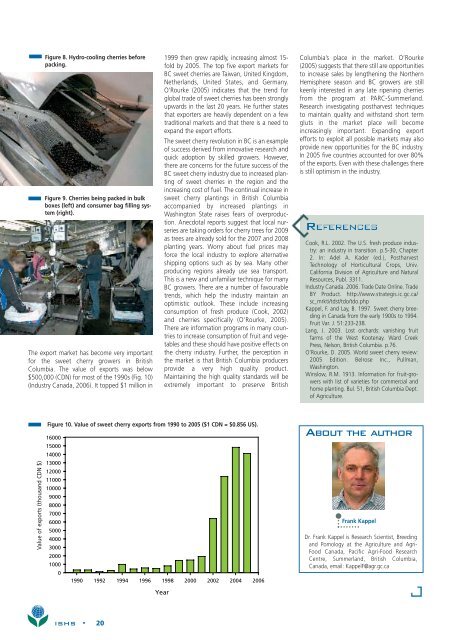Chronica - Acta Horticulturae
Chronica - Acta Horticulturae
Chronica - Acta Horticulturae
You also want an ePaper? Increase the reach of your titles
YUMPU automatically turns print PDFs into web optimized ePapers that Google loves.
Figure 8. Hydro-cooling cherries before<br />
packing.<br />
Figure 9. Cherries being packed in bulk<br />
boxes (left) and consumer bag filling system<br />
(right).<br />
The export market has become very important<br />
for the sweet cherry growers in British<br />
Columbia. The value of exports was below<br />
$500,000 (CDN) for most of the 1990s (Fig. 10)<br />
(Industry Canada, 2006). It topped $1 million in<br />
1999 then grew rapidly, increasing almost 15-<br />
fold by 2005. The top five export markets for<br />
BC sweet cherries are Taiwan, United Kingdom,<br />
Netherlands, United States, and Germany.<br />
O’Rourke (2005) indicates that the trend for<br />
global trade of sweet cherries has been strongly<br />
upwards in the last 20 years. He further states<br />
that exporters are heavily dependent on a few<br />
traditional markets and that there is a need to<br />
expand the export efforts.<br />
The sweet cherry revolution in BC is an example<br />
of success derived from innovative research and<br />
quick adoption by skilled growers. However,<br />
there are concerns for the future success of the<br />
BC sweet cherry industry due to increased planting<br />
of sweet cherries in the region and the<br />
increasing cost of fuel. The continual increase in<br />
sweet cherry plantings in British Columbia<br />
accompanied by increased plantings in<br />
Washington State raises fears of overproduction.<br />
Anecdotal reports suggest that local nurseries<br />
are taking orders for cherry trees for 2009<br />
as trees are already sold for the 2007 and 2008<br />
planting years. Worry about fuel prices may<br />
force the local industry to explore alternative<br />
shipping options such as by sea. Many other<br />
producing regions already use sea transport.<br />
This is a new and unfamiliar technique for many<br />
BC growers. There are a number of favourable<br />
trends, which help the industry maintain an<br />
optimistic outlook. These include increasing<br />
consumption of fresh produce (Cook, 2002)<br />
and cherries specifically (O’Rourke, 2005).<br />
There are information programs in many countries<br />
to increase consumption of fruit and vegetables<br />
and these should have positive effects on<br />
the cherry industry. Further, the perception in<br />
the market is that British Columbia producers<br />
provide a very high quality product.<br />
Maintaining the high quality standards will be<br />
extremely important to preserve British<br />
Columbia’s place in the market. O’Rourke<br />
(2005) suggests that there still are opportunities<br />
to increase sales by lengthening the Northern<br />
Hemisphere season and BC growers are still<br />
keenly interested in any late ripening cherries<br />
from the program at PARC-Summerland.<br />
Research investigating postharvest techniques<br />
to maintain quality and withstand short term<br />
gluts in the market place will become<br />
increasingly important. Expanding export<br />
efforts to exploit all possible markets may also<br />
provide new opportunities for the BC industry.<br />
In 2005 five countries accounted for over 80%<br />
of the exports. Even with these challenges there<br />
is still optimism in the industry.<br />
REFERENCES<br />
Cook, R.L. 2002. The U.S. fresh produce industry:<br />
an industry in transition. p.5-30, Chapter<br />
2. In: Adel A. Kader (ed.), Postharvest<br />
Technology of Horticultural Crops, Univ.<br />
California Division of Agriculture and Natural<br />
Resources, Publ. 3311.<br />
Industry Canada. 2006. Trade Date Online. Trade<br />
BY Product. http://www.strategis.ic.gc.ca/<br />
sc_mrkti/tdst/tdo/tdo.php<br />
Kappel, F. and Lay, B. 1997. Sweet cherry breeding<br />
in Canada from the early 1900s to 1994.<br />
Fruit Var. J. 51:233-238.<br />
Lang, J. 2003. Lost orchards: vanishing fruit<br />
farms of the West Kootenay. Ward Creek<br />
Press, Nelson, British Columbia. p.76.<br />
O’Rourke, D. 2005. World sweet cherry review:<br />
2005 Edition. Belrose Inc., Pullman,<br />
Washington.<br />
Winslow, R.M. 1913. Information for fruit-growers<br />
with list of varieties for commercial and<br />
home planting. Bul. 51, British Columbia Dept.<br />
of Agriculture.<br />
Value of exports (thousand CDN $)<br />
Figure 10. Value of sweet cherry exports from 1990 to 2005 ($1 CDN = $0.856 US).<br />
16000<br />
15000<br />
14000<br />
13000<br />
12000<br />
11000<br />
10000<br />
9000<br />
8000<br />
7000<br />
6000<br />
5000<br />
4000<br />
3000<br />
2000<br />
1000<br />
0<br />
1990 1992 1994 1996 1998 2000 2002 2004 2006<br />
ABOUT THE AUTHOR<br />
Frank Kappel<br />
Dr. Frank Kappel is Research Scientist, Breeding<br />
and Pomology at the Agriculture and Agri-<br />
Food Canada, Pacific Agri-Food Research<br />
Centre, Summerland, British Columbia,<br />
Canada, email: KappelF@agr.gc.ca<br />
Year<br />
ISHS • 20
















